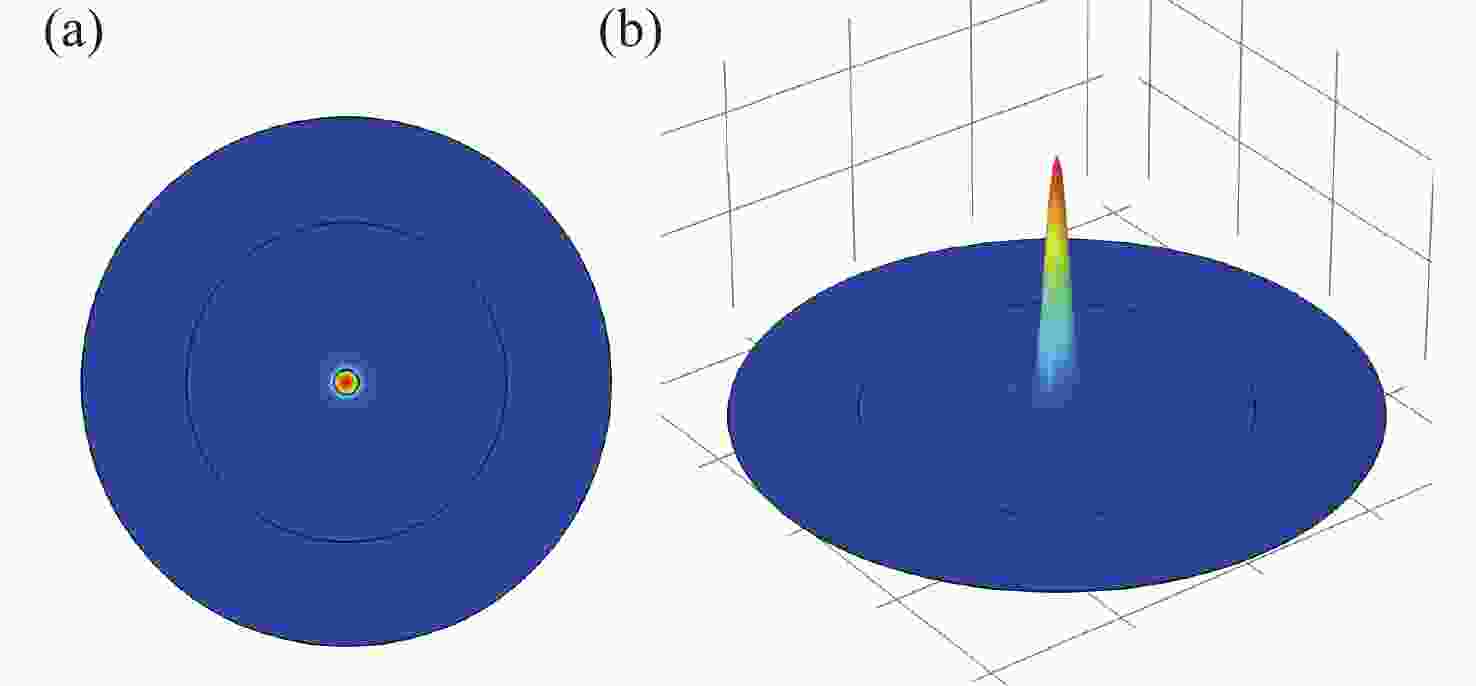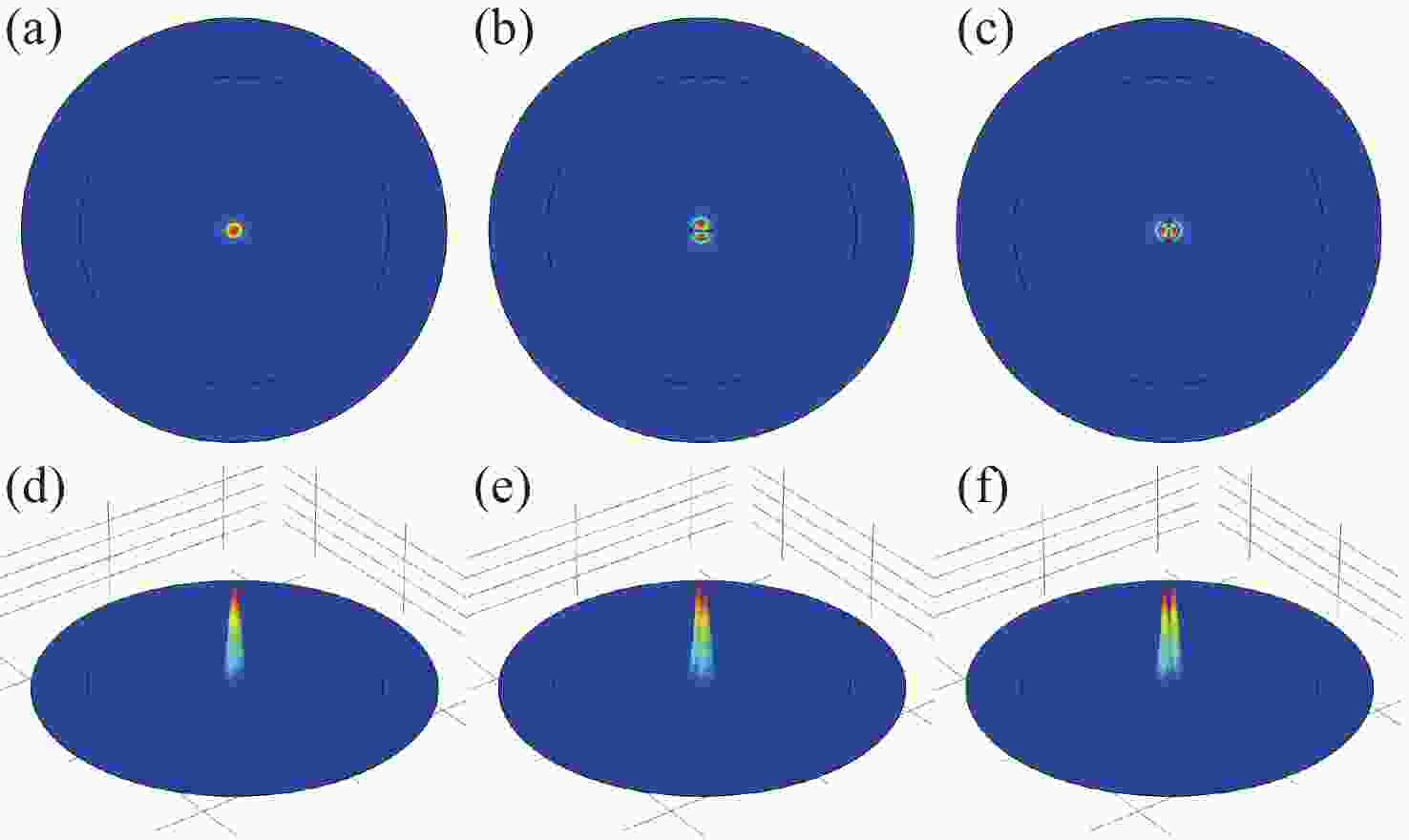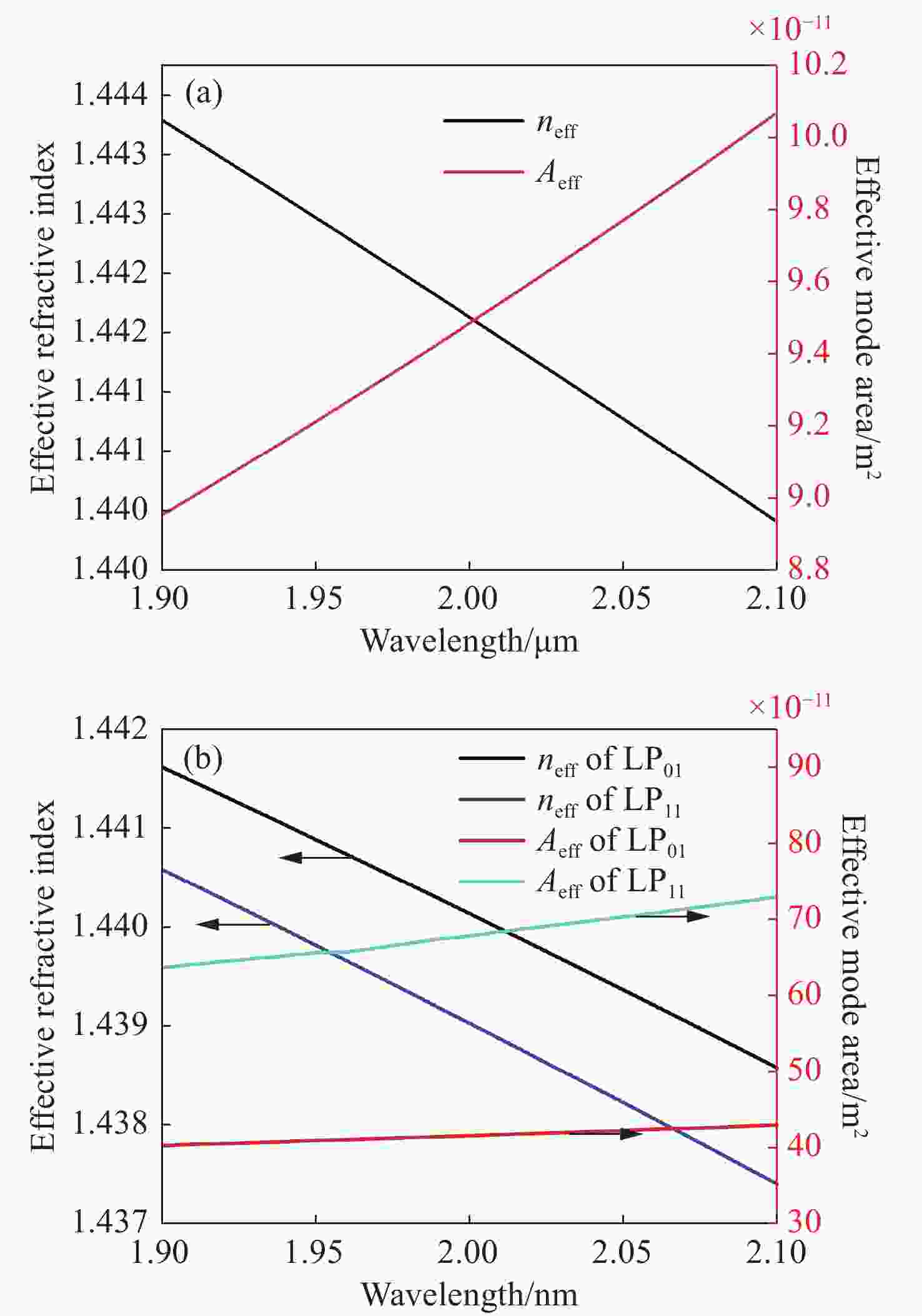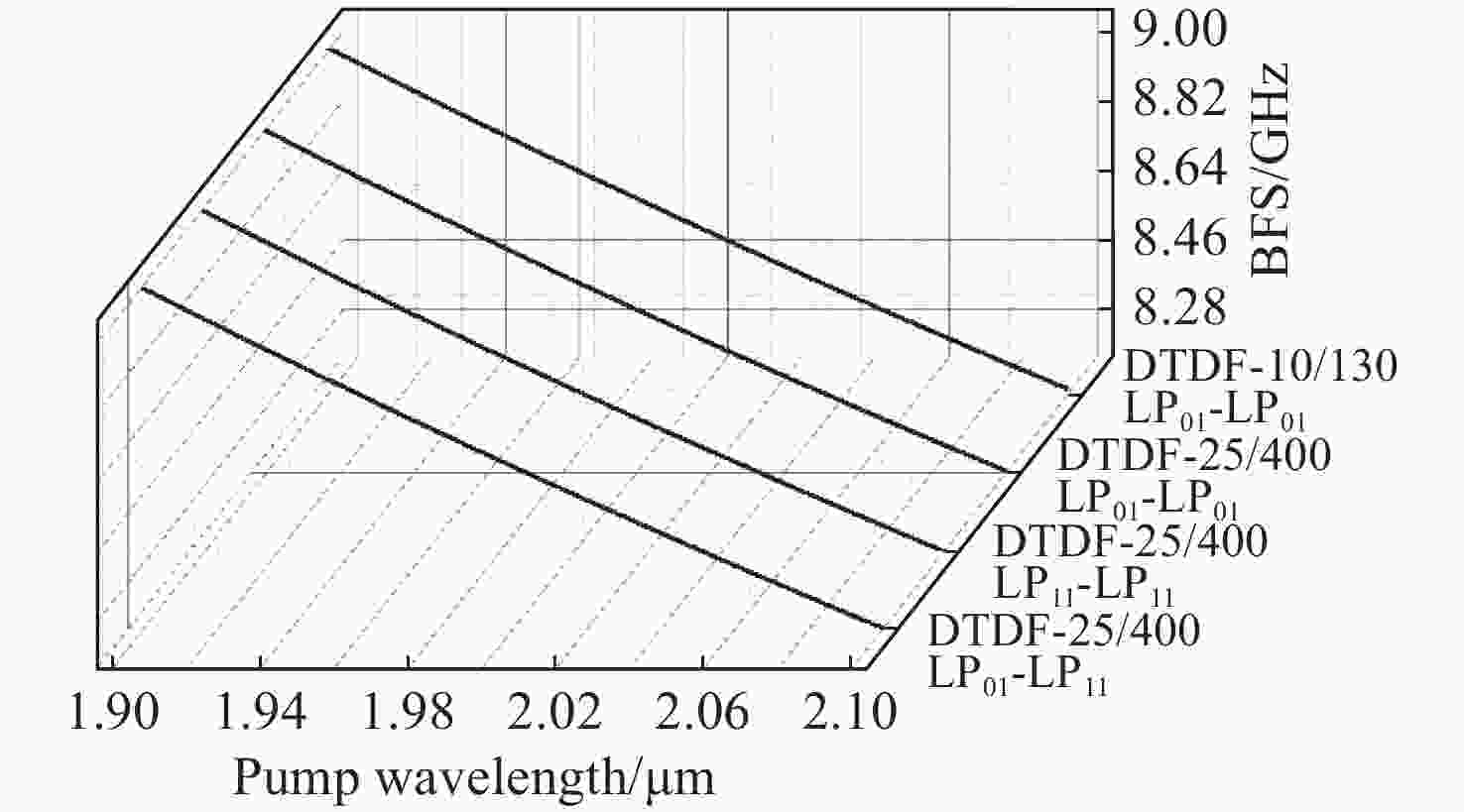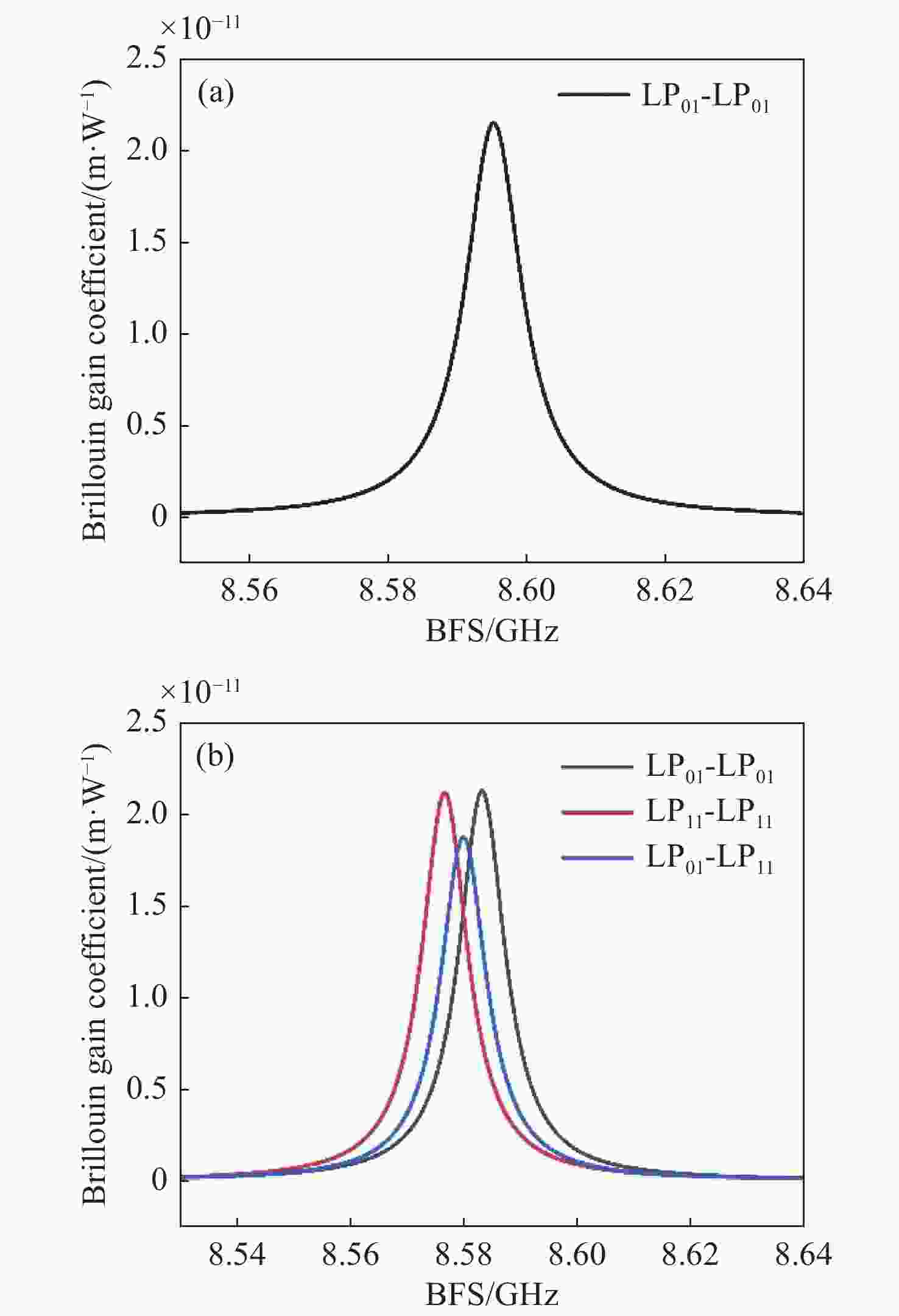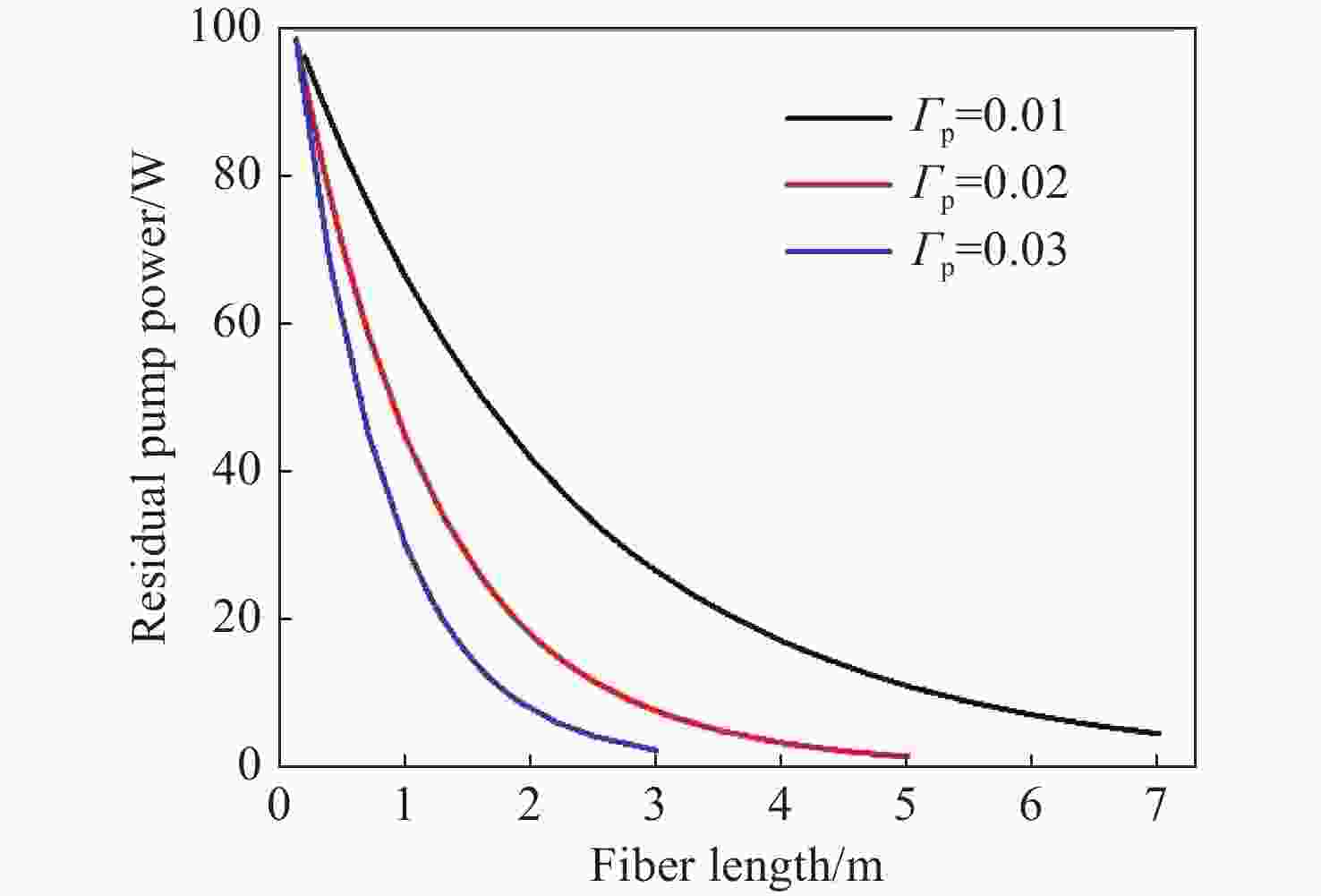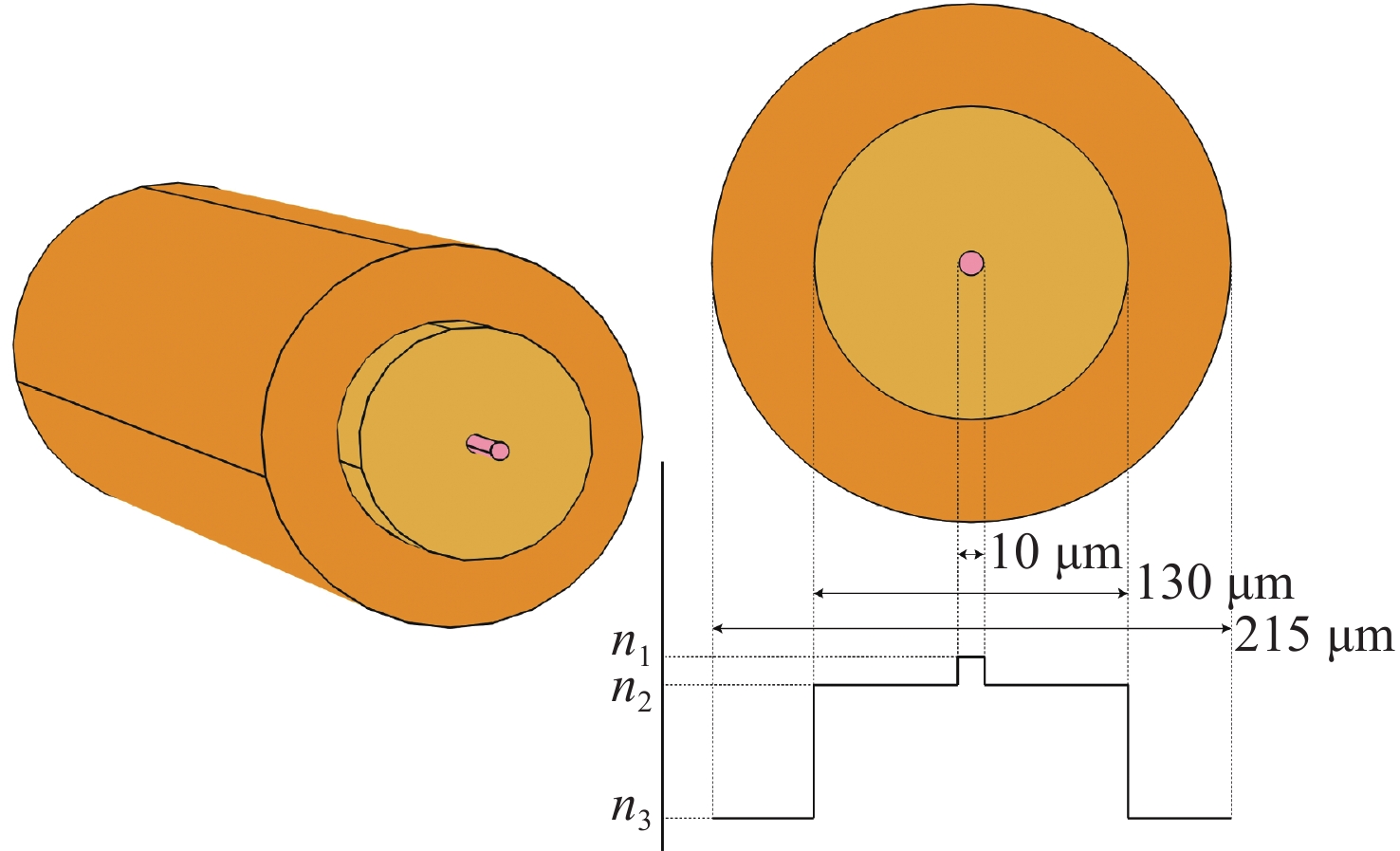Stimulated brillouin scattering in double-clad thulium-doped fiber amplifier
doi: 10.37188/CO.EN-2023-0011
-
摘要:
理论分析了波长为2 µm的掺铥光纤放大器中受激布里渊散射(SBS)对 输出性能的影响,研究了双包层掺铥光纤在793 nm的泵浦波长和1.9~2.1 µm的 工作波段的光模分布、有效折射率、有效模场面积和归一化频率,数值计算了在1.9~2.1µm的 工作波段双包层掺铥光纤中的布里渊频移和布里渊增益谱等SBS特性。利用增益光纤中的受激布里渊散射理论模型,研究了受激布里渊散射对掺铥光纤放大器 输出性能的影响。在DTDF-10/130双包层掺铥光纤中,使用功率为100 W、波长为793 nm的连续光作为泵浦,可对波长为2 μm、功率为0.01 W的连续信号光进行放大。当泵浦光功率填充因子为0.01、0.02和0.03时,信号光的最大输出功率分别为25.27 W、31.08 W和34.06 W。对应的最佳双包层光纤长度为2.66 m、2.02 m和1.75 m,由受激布里渊散射产生的斯托克斯光功率分别为1.68 W、1.39 W和1.14 W。结果表明,在掺铥光纤放大器中使用泵浦光功率填充因子大的双包层光纤可以降低光纤长度,从而减小受激布里渊散射对信号 输出功率的影响。本文的数值模型可以对光纤放大器的光纤长度进行优化,对提高实验效率、降低实验成本具有重要价值。
Abstract:In this paper, the effect of Stimulated Brillouin Scattering(SBS) on the laser output performance in a 2 µm thulium-doped fiber amplifier was analyzed theoretically. The optical mode distribution, the effective refractive index, the effective mode field area, and the normalized frequency of the double-clad thulium-doped fiber at 793 nm pump wavelength and 1.9−2.1 µm laser waveband were studied. The stimulated Brillouin scattering characteristics, including the Brillouin frequency shift and the Brillouin gain spectrum, in the double-clad thulium-doped fiber were numerically simulated in the laser waveband of 1.9−2.1 µm. The influence of stimulated Brillouin scattering on the laser output performance of thulium-doped fiber amplifiers was investigated using the theoretical model of stimulated Brillouin scattering in gain fibers. In the DTDF-10/130 double-clad thulium-doped fiber, a continuous wave with power of 100 W and wavelength of 793 nm is used as a pump to amplify a continuous signal wave with wavelength of 2 µm and power of 0.01 W. The maximum output powers of the signal wave are 25.27 W, 31.08 W and 34.06 W when the pump power filling factors are 0.01, 0.02 and 0.03, respectively. The corresponding optimal double-clad fiber lengths are 2.66 m, 2.02 m and 1.75 m. Additionally, the Stokes optical powers generated by the stimulated Brillouin scattering are 1.68 W, 1.39 W and 1.14 W, respectively. The results show that the double-clad fiber with large pump power filling factor in the thulium-doped fiber amplifier can effectively reduce the fiber length, thus to minimize the influence of stimulated Brillouin scattering on the output power of the signal laser. The numerical model can optimize the fiber length of the fiber amplifier, which is of great significance to improve experimental efficiency and reduce experimental costs.
-
Key words:
- stimulated brillouin scattering /
- double-clad /
- thulium-doped fiber /
- amplifier
-
Figure 4. Optical field distribution of DTDF-25/400 double-clad thulium-doped fiber at 2 µm wavelength. (a)−(c) Schematic diagrams of the two-dimensional optical field distributions for LP01, LP11 (o) and LP11 (e); (d)−(f) schematic diagrams of three-dimensional optical field distributions for LP01, LP11 (o) and LP11 (e)
Table 1. Geometry and optical properties of double-clad thulium-doped fibers
Properties Unit DTDF-10/130 DTDF-25/400 Core diameter µm 10.0 ± 1.0 25.0 ± 2.5 Diameter of inner cladding µm 130.0 ± 3.0 400.0 ± 15.0 Concentricity error of core/internal cladding µm ≤ 2.0 ≤ 4.0 Diameter of coating layer µm 215.0 ± 10.0 550.0 ± 20 Operating wavelength nm 1900 ~ 2100 1900 ~ 2100 Core numerical aperture —— 0.150 ± 0.010 0.090 ± 0.010 Numerical aperture of inner cladding —— ≥ 0.460 ≥ 0.460 Table 2. Simulation parameters of thulium-doped fiber amplifier
Parameter Symbol Value Unit Fiber core diameter a 10.0 µm Inner cladding diameter b 130.0 µm Tm3+ doping concentration N0 5.5×1025 m−3 Pump wavelength λp 793 nm Signal wave wavelength λs 2 µm Pump wave absorption cross section σa(λp) 8.5×10−25 m2 Pump wave emission cross section σe(λp) 8.9×10−25 m2 Signal wave absorption cross section σa(λs) 0.1×10−25 m2 Signal wave emission cross section σe(λs) 6.2×10−25 m2 Stimulated Brillouin scattering gain gB 2.803×10−11 m/W Brillouin noise ISBS 3.350×10−7 W Pumped optical fiber loss αp 1.2×10−2 m−1 Signal optical fiber loss αs 2.3×10−3 m−1 Pump optical power filling factor Γp Influenced by the shape of the inner cladding - Signal optical power filling factor Γs 0.817 - -
[1] YAO J Q, REN G J, ZHANG Q, et al. Ytterbium-doped double clad fiber laser and pump coupling technology[J]. Laser Journal, 2006, 27(5): 1-4. (in Chinese). [2] LIU W W, SONG F, LI J, et al. Cladding pumping upconversion fiber laser[J]. Laser Journal, 2000, 21(1): 10-12. (in Chinese). doi: 10.3969/j.issn.0253-2743.2000.01.001 [3] LIU Q, YANG SH P, LEI J. Cladding pump fiber lasers and its application[J]. Optical Communication Technology, 2005, 29(6): 54-56. (in Chinese). [4] SNITZER E, PO H, HAKIMI F, et al. Double clad, offset core Nd fiber laser[C]. Optical Fiber Sensors 1988, Optica Publishing Group, 1988. [5] ZHANG H R, ZHANG J J, SUN SH ZH, et al. Self-mode-locking and self-phase modulation in Tm3+-doped double clad fiber laser for pulse peak power enhancement and multi-wavelength generation[J]. Optics & Laser Technology, 2021, 141: 107128. [6] DURÁN-SÁNCHEZ M, POSADA-RAMÍREZ B, ÁLVAREZ-TAMAYO R I, et al. Low repetition rate gain-switched double-clad thulium-doped fiber laser operating in the 2µm wavelength region[J]. Optical Fiber Technology, 2021, 66: 102660. doi: 10.1016/j.yofte.2021.102660 [7] SHEN Y H, WU B, HU CH ZH, et al. Experimental investigation on the high average power ns mid-infrared laser output at 3.8μm through difference frequency generation[J]. Chinese Journal of Lasers, 2022, 49(1): 0101017. (in Chinese). [8] ZHONG P L, WANG L, YANG B L, et al. 2 × 2kW near-single-mode bidirectional high-power output from a single-cavity monolithic fiber laser[J]. Optics Letters, 2022, 47(11): 2806-2809. doi: 10.1364/OL.458581 [9] HUANG ZH M, SHU Q, TAO R M, et al. >5kW record high power narrow linewidth laser from traditional step-index monolithic fiber amplifier[J]. IEEE Photonics Technology Letters, 2021, 33(21): 1181-1184. doi: 10.1109/LPT.2021.3112270 [10] XU Y, SHENG Q, WANG P, et al. 1. 5-kW all-fiberized Yb-doped MOPA laser at 1105nm with near-diffraction-limited beam quality and narrow spectral width[J]. Optics Communications, 2022, 511: 127893. [11] ZHANG A J, DUAN J L, XING Y B, et al. Application of thulium-doped laser in the biomedicine field[J]. Laser & Optoelectronics Progress, 2022, 59(1): 0100004. (in Chinese). [12] CHEN Y L, ZHU X L, ZHANG J X, et al. Development of pulsed single-frequency 2μm all-solid-state laser[J]. Laser & Optoelectronics Progress, 2020, 57(5): 050006. (in Chinese). [13] SINGH U N, KAVAYA M, KOCH G, et al. Solid-state 2-micron laser transmitter advancement for wind and carbon dioxide measurements from ground, airborne, and space-based lidar systems[J]. Proceedings of SPIE, 2008, 7111: 711104. doi: 10.1117/12.802740 [14] SINGH U N, WALSH B M, YU J R, et al. Twenty years of Tm: Ho: YLF and LuLiF laser development for global wind and carbon dioxide active remote sensing[J]. Optical Materials Express, 2015, 5(4): 827-837. doi: 10.1364/OME.5.000827 [15] WULFMEYER V, RANDALL M, BREWER A, et al. 2-μm Doppler lidar transmitter with high frequency stability and low chirp[J]. Optics Letters, 2000, 25(17): 1228-1230. doi: 10.1364/OL.25.001228 [16] ISHII S, MIZUTANI K, IWAI H, et al. 2-µm coherent lidar technology developed at NICT: past, current, and future[C]. Applications of Lasers for Sensing and Free Space Communications 2015, Optica Publishing Group, 2015. [17] WANG X F, WANG J, DUAN X Y. Experimental investigation on evolution of a split multi-wavelength bright-dark pulse in a mode-locked thulium-doped fiber laser[J]. Optoelectronics Letters, 2022, 18(12): 717-722. doi: 10.1007/s11801-022-2089-3 [18] SONG W H, PENG ZH G, HOU Y B, et al. High-power wavelength-tunable ultrashort pulse firer laser at 2 μm[J]. High Power Laser and Particle Beams, 2022, 34(3): 031002. (in Chinese). [19] YING G, FENG P Y, TING F, et al. Wavelength-interval-switchable multi-wavelength thulium-doped fiber laser with a nonlinear dual-pass Mach-Zehnder interferometer filter in 2-µm-band[J]. Optics & Laser Technology, 2022, 145: 107470. [20] GUAN B, YAN F P, YANG D D, et al. Sub-kHz narrow-linewidth single-longitudinal-mode thulium-doped fiber laser utilizing triple-coupler ring-based compound-cavity filter[J]. Photonics, 2023, 10(2): 209. doi: 10.3390/photonics10020209 [21] YANG B L, YAGN H, YE Y, et al. 6 kW broadband fiber laser based on home-made ytterbium-doped fiber with gradually varying spindle-shape structure[J]. High Power Laser and Particle Beams, 2022, 34(8): 081001. (in Chinese). [22] LIU CH, LIU J, ZHANG Y J, et al. Stimulated Brillouin scattering suppression of thulium-doped fiber amplifier with fiber superfluorescent seed source[J]. Optics Express, 2017, 25(9): 9569-9578. doi: 10.1364/OE.25.009569 [23] KOVALEV V I, HARRISON R G, NILSSON J, et al. Analytic modeling of Brillouin gain in rare-earth doped fiber amplifiers with high-power single-frequency signals[J]. Proceedings of SPIE, 2005, 5709: 142-146. doi: 10.1117/12.591913 [24] YANG L, ZHENG J J, HAO L Y, et al. Influence of signal spectral width characteristic on SBS threshold of single frequency fiber amplifier[J]. Chinese Journal of Lasers, 2017, 44(9): 0901009. (in Chinese). doi: 10.3788/CJL201744.0901009 [25] LIU Y K, WANG X L, SU R T, et al. Effect of phase modulation on linewidth and stimulated Brillouin scattering threshold of narrow-linewidth fiber amplifiers[J]. Acta Physica Sinica, 2017, 66(23): 234203. (in Chinese). doi: 10.7498/aps.66.234203 [26] HARISH A V, NILSSON J. Suppression of stimulated Brillouin scattering in pulsed erbium-doped fiber amplifier through intensity-modulated counter pumping[J]. Optical Engineering, 2019, 58(10): 102703. [27] HUANG B, WANG J Q, SHAO X P. Fiber-based techniques to suppress stimulated brillouin scattering[J]. Photonics, 2023, 10(3): 282. doi: 10.3390/photonics10030282 [28] TIAN H, SHI CH D, FU SH J, et al. 0.59-mJ single-frequency Yb-3+-doped hundred-nanosecond pulsed all-fiber laser[J]. Chinese Journal of Lasers, 2022, 49(13): 1301005. (in Chinese). doi: 10.3788/CJL202249.1301005 [29] 全国通信标准化技术委员会. GB/T 28504.2-2021 掺稀土光纤 第2部分: 双包层掺铥光纤特性[S]. 北京: 中国标准出版社, 2021.National Communications Standardization Technical Committee. GB/T 28504.2-2021 Rare earth doped optical fibre—Part 2: Characteristics of double-cladding thulium-doped optical fibre[S]. Beijing: Standards Press of China, 2021. (in Chinese). [30] LIU Q M, CHEN J P, HOU SH L, et al. Investigation into micro-polishing photonic crystal fibers for surface plasmon resonance sensing[J]. Crystals, 2022, 12(8): 1106. doi: 10.3390/cryst12081106 [31] GILES C R, DESURVIRE E. Modeling erbium-doped fiber amplifiers[J]. Journal of Lightwave Technology, 1991, 9(2): 271-283. doi: 10.1109/50.65886 [32] HUANG L J, YAO T F, YANG B H, et al. Modified single trench fiber with effective single-mode operation for high-power application[J]. IEEE Journal of Selected Topics in Quantum Electronics, 2018, 24(3): 0901409. [33] JACKSON S D, KING T A. Theoretical modeling of Tm-doped silica fiber lasers[J]. Journal of Lightwave Technology, 1999, 17(5): 948-956. doi: 10.1109/50.762916 [34] SHEN X, ZHOU J H, YANG G L, et al. Temperature characteristics analysis of a Tm3+-doped heterogeneous helical cladding fiber amplifier[J]. Applied Physics B, 2022, 128(12): 221. doi: 10.1007/s00340-022-07936-2 [35] FANG Q, SHI W, KIEU K, et al. High power and high energy monolithic single frequency 2 µm nanosecond pulsed fiber laser by using large core Tm3+-doped germanate fibers: experiment and modeling[J]. Optics Express, 2012, 20(15): 16410-16420. doi: 10.1364/OE.20.016410 -






 下载:
下载:

